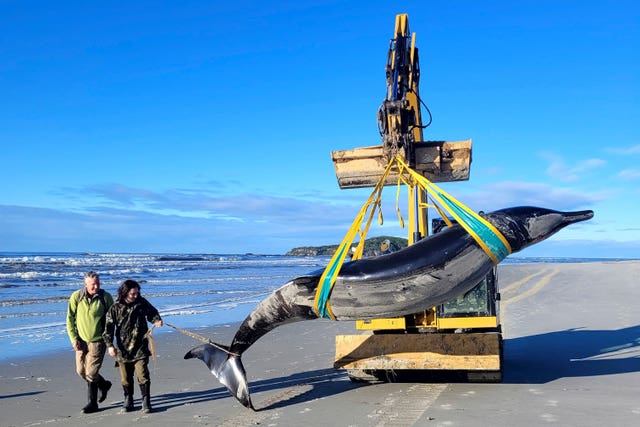One of the world’s rarest whales may have washed up on a New Zealand beach – providing researchers with vital information on how the creatures live.
It is thought that the dead mammal which was found on a South Island beach is a spade-toothed whale, which has never been seen alive in the wild.
No-one knows how many there are, what they eat, or even where they live in the vast expanse of the southern Pacific Ocean.
New Zealand’s conservation agency said the five-metre-long (16ft) creature, a type of beaked whale, was identified by its colour patterns and the shape of its skull, beak and teeth, after it washed ashore on Otago beach earlier this month.
Hannah Hendriks, marine technical adviser for the country’s department of conservation, said: “We know very little, practically nothing” about the creatures.
“This is going to lead to some amazing science and world-first information.”

Only six other spade-toothed whales have ever been pinpointed, and those found intact on New Zealand’s North Island beaches had been buried before DNA testing could verify their identification, Ms Hendriks said.
This time, the beached whale was quickly transported to cold storage and researchers will work with local Maori iwi (tribes) to plan how it will be examined, the conservation agency said.
New Zealand’s Indigenous people consider whales a taonga – a sacred treasure – of cultural significance.
In April, Pacific Indigenous leaders signed a treaty recognizing whales as “legal persons”, although such a declaration is not reflected in the laws of participating nations.
Nothing is currently known about the whales’ habitat. The creatures deep-dive for food and likely surface so rarely that it has been impossible to narrow their location further than the southern Pacific Ocean, home to some of the world’s deepest ocean trenches, Ms Hendriks said.
The conservation agency said the genetic testing to confirm the whale’s identification could take months.
It took “many years and a mammoth amount of effort by researchers and local people” to identify the “incredibly cryptic” mammals, Kirsten Young, a senior lecturer at the University of Exeter who has studied spade-toothed whales, said in emailed remarks.
The fresh discovery “makes me wonder – how many are out in the deep ocean and how do they live?” Ms Young said.
The first spade-toothed whale bones were found in 1872 on New Zealand’s Pitt Island. Another discovery was made at an offshore island in the 1950s, and the bones of a third were found on Chile’s Robinson Crusoe Island in 1986.
DNA sequencing in 2002 proved that all three specimens were of the same species – and that it was one distinct from other beaked whales.
Researchers studying the mammal could not confirm if the species went extinct. Then in 2010, two, whole, spade-toothed whales, both dead, washed up on a New Zealand beach.
Firstly mistaken for one of New Zealand’s 13 other more common types of beaked whale, tissue samples – taken after they were buried – revealed them as the enigmatic species.
New Zealand is a whale-stranding hotspot, with more than 5,000 episodes recorded since 1840, according to the Department of Conservation.






